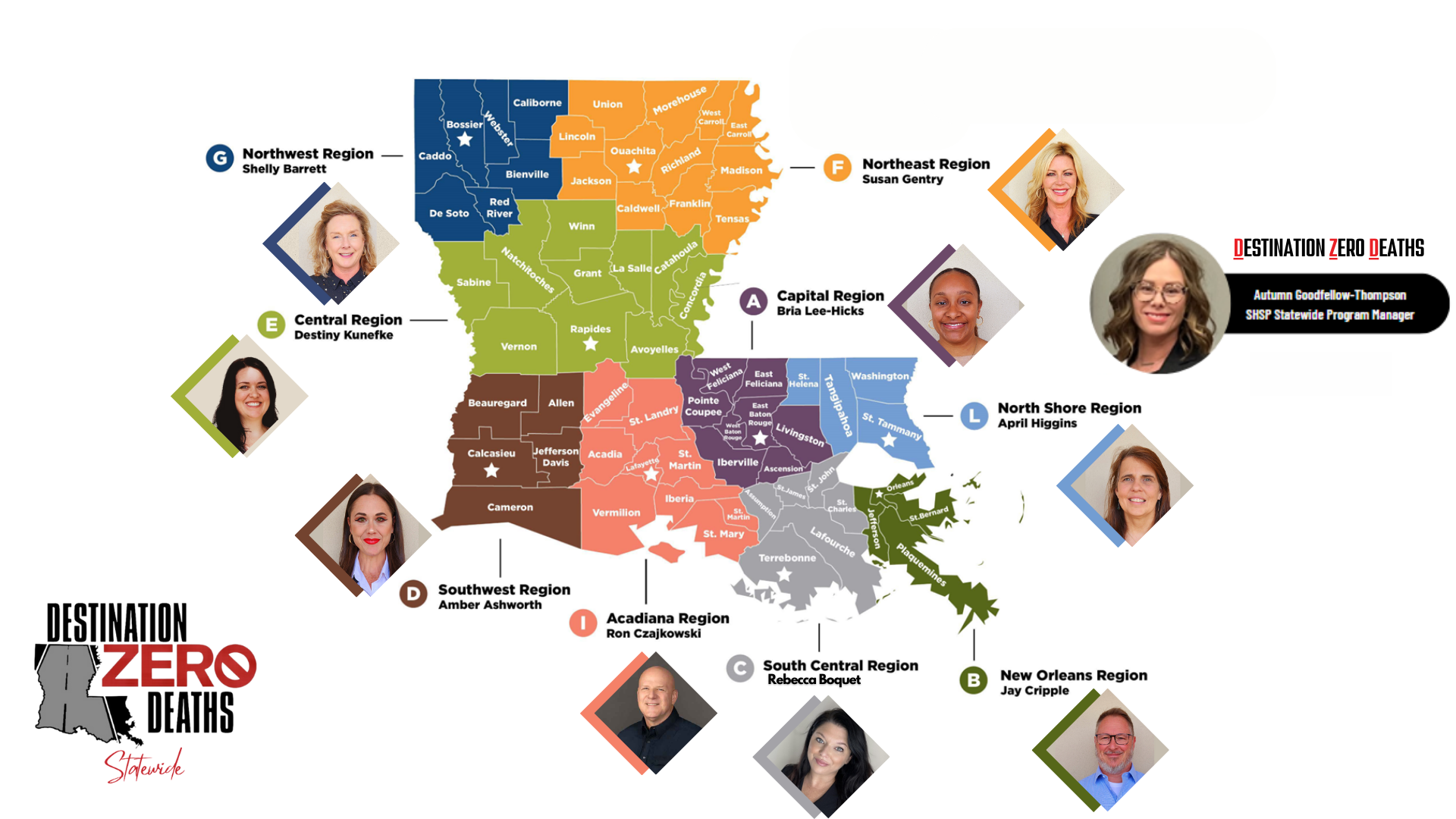Search
Strategic Highway Safety Plan
The Strategic Highway Safety Plan provides a framework of safety strategies and tactics for reducing fatalities and serious injuries on all roadways within the state through data-driven analysis and multidisciplinary coordination and input. The Louisiana Department of Transportation and Development, the Louisiana State Police, the Louisiana Highway Safety Commission, and stakeholders have focused this plan on addressing four key Emphasis Areas (below).
Toward Zero Deaths is a national strategy geared toward eliminating traffic-related fatalities on United States roadways. The national strategy serves as a springboard for state, regional, and local level safety programs, specifically Louisiana’s Destination Zero Deaths initiative.
| SHSP Program Manager |
Autumn Goodfellow-Thompson 225-379-1838 |
SHSP Emphasis Areas
Distracted Driving
Distracted or inattentive driving crashes are defined as crashes involving at least one driver or motorcyclist having either a driver condition of “distracted/inattentive” or a driver distraction of “cell phone,” “other electronic device,” “other inside the vehicle,” or “other outside the vehicle” as determined by the police officer.
- Distracted and inattentive crashes accounted for nearly one-third of all fatal and serious injury crashes, which occurred mostly on state roadways and two-way undivided highways.
- Most distracted driving fatalities and serious injuries did not involve a collision with another vehicle. Where a collision did occur, most were rear-end and angle crashes.
- More than one-third of all distracted driving fatalities and serious injuries occurred at intersections.
- Females, young drivers, commercial motor vehicles, and motorcyclists had a higher-than average chance of being involved in a crash.
Impaired Driving
The Impaired Driving includes crashes associated with alcohol or other drugs. An alcohol-related crash is defined as a crash involving at least one driver or motorcyclist predicted to have a BAC greater than or equal to 0.02%. A drug-involved crash is defined as a crash involving a driver or motorcyclist identified by the police officer as either having a condition of drug use (whether impaired or not impaired), being suspected of having used drugs or both alcohol and drugs, or having drugs that were reported.
- Alcohol-related crashes contributed to approximately one-third of all fatalities in Louisiana between 2016 and 2020.
- Two-thirds of alcohol-related fatalities and serious injuries were single-vehicle crashes occurring during dark conditions between the hours of 6 p.m. and 3 a.m.
- Males were much more likely to drive impaired, and the highest age concentration of drivers was between 25 and 34 years old (male and female).
- Drug-involved crashes contributed to more than half of all fatalities in Louisiana between 2016 and 2020.
- Approximately one-quarter of drug involved crashes involved young drivers, and a nearly equal amount involved older drivers.
- Most drug-involved crashes occurred between 3 p.m. and 3 a.m., with the highest peak occurring from 6 p.m. to 9 p.m.
- Most drug-involved serious injuries and fatalities have been highly correlated with males between 25 and 34 years of age.
- Drug-involved crashes have been highly correlated with lane departure, roadway departure, and no restraint usage.
Occupant Protection
Crashes within the Occupant Protection (No Restraint) emphasis area are defined as crashes involving a driver or occupant not using or improperly using their seatbelt. A “no restraint” person is a driver or occupant not using or improperly using their seatbelt. This includes child restraints, as well.
- Occupant protection crashes made up one-third of all statewide fatalities and 18% of all serious injury related crashes in Louisiana.
- Most fatalities and injuries related to occupant protection were due to drivers not wearing restraint
devices. - Nearly two-thirds of fatalities and serious injuries related to no restraint usage involved a single vehicle.
- Most occurred between 3 p.m. and 3 a.m., with the highest peak occurring from 9 p.m. to midnight under dark conditions.
- Approximately one-quarter occurred at intersections, while the rest occurred on two-way undivided
roadways. - Males were more likely to avoid restraint use, and similar to impaired drivers, most were between the
ages of 25 to 34 years old.
Infrastructure and Operations
The Infrastructure and Operations emphasis area comprises crashes involving lane departure, including roadway departure and head-on collisions, intersections, and crashes between vehicles and non-motorized users, such as pedestrians or bicycles. For more information on Infrastructure and Operations emphasis areas, please see the Highway Safety Improvement Program Infrastructure Emphasis Areas.
Regional Transportation Safety Coalitions
Local stakeholder participation is vital in implementing the vision of Destination Zero Deaths. To accelerate the SHSP’s project implementation at the local level, Louisiana established nine Regional Transportation Safety Coalitions through an agreement between DOTD and the designated Regional Planning Commission or the Metropolitan Planning Organization. For more information on the Regional Transportation Safety Coalitions, please visit DestinationZeroDeaths.com

